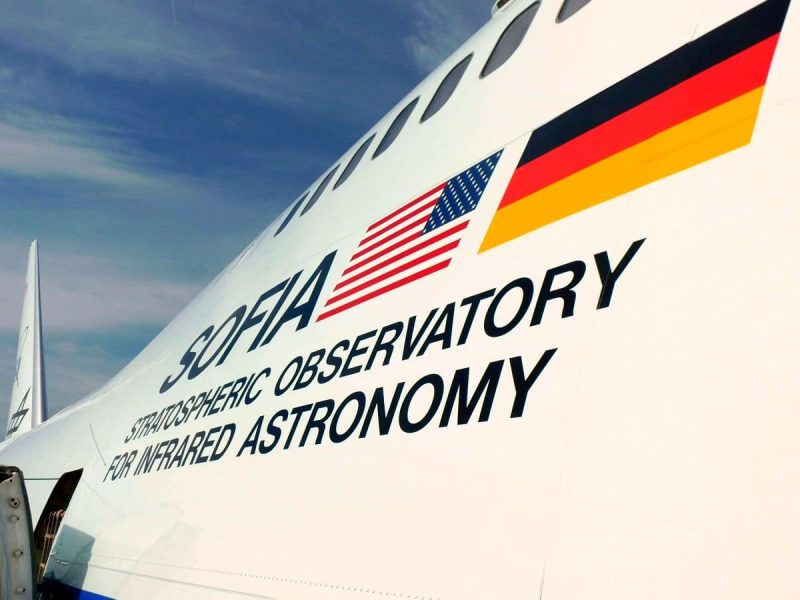The Boeing 747SP, registration N747NA, also known as "Sofia", will be retired in September 2022. Nasa and DLR have been operating this machine together as a research laboratory since 2014.
The continued operation of the “Sofia” was already under scrutiny under the presidency of Donald Trump. Ultimately, however, it was decided to continue using the stratospheric observatory for infrared astronomy. In September 2022, however, it should finally be over. Nasa and DLR have jointly decided to shut down the machine.
“SOFIA's flight operations have contributed in an excellent way to the long history of German-American cooperation. We look forward to building on that,” said NASA Director of Science Thomas Zurbuchen. "In a joint workshop in the summer, we want to develop new projects in future scientific fields with DLR."

Boeing 747SP “Sofia” (Photo: Jan Gruber). 
Boeing 747SP “Sofia” (Photo: Jan Gruber). 
Boeing 747SP “Sofia” (Photo: Jan Gruber). 
Boeing 747SP “Sofia” (Photo: Jan Gruber). 
Boeing 747SP “Sofia” (Photo: Jan Gruber). 
Boeing 747SP “Sofia” (Photo: Jan Gruber). 
Boeing 747SP “Sofia” (Photo: Jan Gruber). 
Boeing 747SP “Sofia” (Photo: Jan Gruber). 
Boeing 747SP “Sofia” (Photo: Jan Gruber). 
Boeing 747SP “Sofia” (Photo: Jan Gruber). 
Boeing 747SP “Sofia” (Photo: Jan Gruber). 
Boeing 747SP “Sofia” (Photo: Jan Gruber). 
Boeing 747SP “Sofia” (Photo: Jan Gruber). 
Boeing 747SP “Sofia” (Photo: Jan Gruber). 
Boeing 747SP “Sofia” (Photo: Jan Gruber). 
Boeing 747SP “Sofia” (Photo: Jan Gruber). 
Boeing 747SP “Sofia” (Photo: Jan Gruber). 
Boeing 747SP “Sofia” (Photo: Jan Gruber).
SOFIA scientific data is available in NASA archives for astronomers worldwide. Converted into an observatory for infrared astronomy, the Boeing 747 SP completed its five-year main mission in 2019 and extended it for another three years to 2022. The SOFIA cooperation between NASA and the German Space Agency at DLR has been agreed in a mutual agreement. It determines the distribution of the work packages. Germany supplied the world's only 2,7-meter telescope, which is built into SOFIA's fuselage, and contributes 20 percent to the operating costs. In return, groups of scientists from Germany were allocated around 30 scientific flights per year. NASA bought the used Boeing 747 and modified it to accommodate the telescope. NASA also operates the Palmdale Observatory in California, SOFIA's home base.
SOFIA has completed around 2014 scientific flights annually since 100. Astronomical objects were mainly observed in our Milky Way. The Infrared Observatory specializes in far-infrared observations. In particular, it provides contributions to questions of astro-chemistry and astro-physics. The first molecule - helium hydride - to form in the universe almost 14 billion years ago was first astrophysically detected by SOFIA in 2019. The detection was made with the GREAT instrument, a development of the Bonn MPIfR, the University of Cologne and the Berlin DLR Institute for Optosystems.

Boeing 747SP “Sofia” (Photo: Jan Gruber). 
Boeing 747SP “Sofia” (Photo: Jan Gruber). 
Boeing 747SP “Sofia” (Photo: Jan Gruber). 
Boeing 747SP “Sofia” (Photo: Jan Gruber). 
Boeing 747SP “Sofia” (Photo: Jan Gruber). 
Boeing 747SP “Sofia” (Photo: Jan Gruber). 
Seats in the Boeing 747SP “Sofia” (Photo: Jan Gruber). 
Equipment in the Boeing 747SP “Sofia” (Photo: Jan Gruber). 
Equipment in the Boeing 747SP “Sofia” (Photo: Jan Gruber). 
Equipment in the Boeing 747SP “Sofia” (Photo: Jan Gruber). 
Equipment in the Boeing 747SP “Sofia” (Photo: Jan Gruber). 
Boeing 747SP “Sofia” (Photo: Jan Gruber). 
Boeing 747SP “Sofia” (Photo: Jan Gruber). 
Equipment in the Boeing 747SP “Sofia” (Photo: Jan Gruber). 
Equipment in the Boeing 747SP “Sofia” (Photo: Jan Gruber). 
Seats in the Boeing 747SP “Sofia” (Photo: Jan Gruber). 
Boeing 747SP “Sofia” (Photo: Jan Gruber). 
Stairs in the Boeing 747SP “Sofia” (Photo: Jan Gruber).
SOFIA also researched how galaxies develop and how stars and planetary systems form from interstellar clouds of molecules and dust. This was made possible by the special telescope developed and manufactured in Germany with a diameter of 2,7 meters and a weight of 17 tons. SOFIA can use six different scientific instruments, three of which are from Germany – two far-infrared instruments and one optical instrument.
The airborne observatory is based in Palmdale, California, and conducts most observation flights from there. However, it was also used worldwide for astronomical observations, most recently in Chile in March 2022 and in Cologne in March 2021. For observations of astronomical objects in the southern sky, SOFIA was regularly operated from Christchurch in New Zealand.

Cockpit of the Boeing 747SP “Sofia” (Photo: Jan Gruber). 
Cockpit of the Boeing 747SP “Sofia” (Photo: Jan Gruber). 
Cockpit of the Boeing 747SP “Sofia” (Photo: Jan Gruber). 
Cockpit of the Boeing 747SP “Sofia” (Photo: Jan Gruber). 
Cockpit of the Boeing 747SP “Sofia” (Photo: Jan Gruber). 
Cockpit of the Boeing 747SP “Sofia” (Photo: Jan Gruber). 
Equipment of the Boeing 747SP “Sofia” (Photo: Jan Gruber). 
Equipment of the Boeing 747SP “Sofia” (Photo: Jan Gruber). 
Equipment of the Boeing 747SP “Sofia” (Photo: Jan Gruber). 
Equipment of the Boeing 747SP “Sofia” (Photo: Jan Gruber). 
Equipment of the Boeing 747SP “Sofia” (Photo: Jan Gruber). 
Equipment of the Boeing 747SP “Sofia” (Photo: Jan Gruber). 
Equipment of the Boeing 747SP “Sofia” (Photo: Jan Gruber). 
Boeing 747SP “SOFIA” (Photo: Jan Gruber). 
Cockpit of the Boeing 747SP “SOFIA” (Photo: Jan Gruber). 
Boeing 747SP “SOFIA” (Photo: Jan Gruber). 
Telescope in the Boeing 747SP “SOFIA” (Photo: Jan Gruber). 
Boeing 747SP “SOFIA” (Photo: Jan Gruber).







 trail (for them it's free to use)
trail (for them it's free to use)